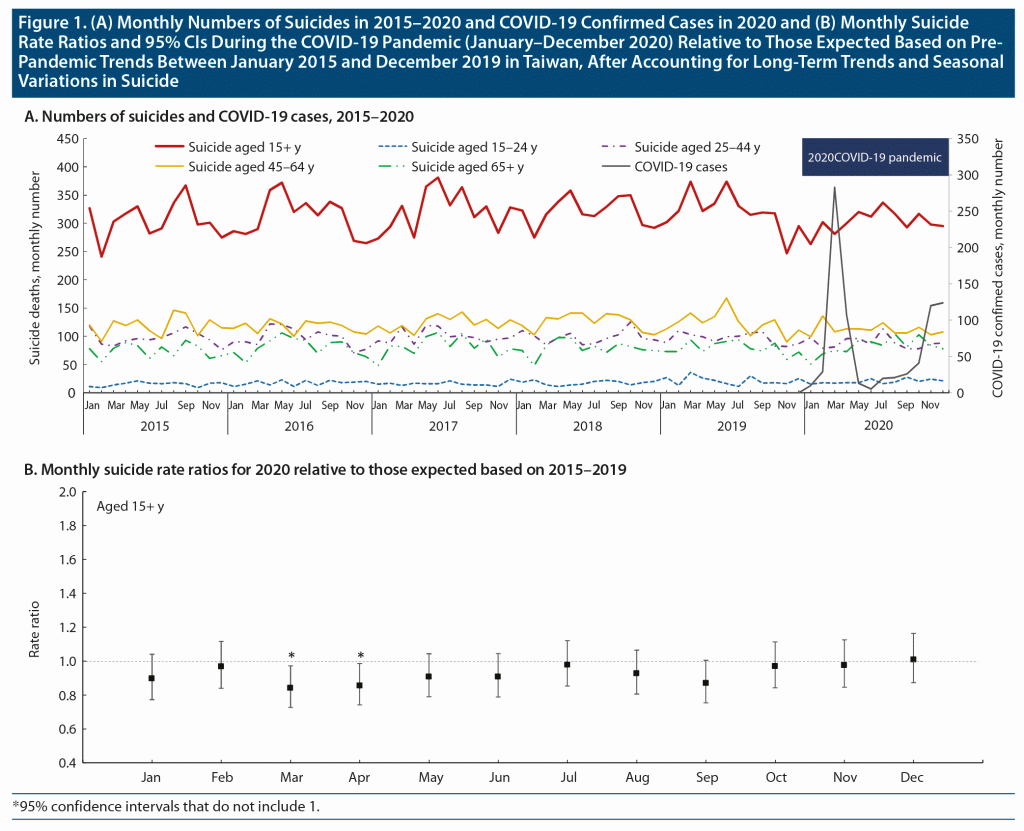
J Clin Psychiatry 2021;82(6):21br14137
To cite: Lin C-Y, Chang S-S, Shen L-J. Decrease in suicide during the first year of the COVID-19 pandemic in Taiwan. J Clin Psychiatry. 2021;82(6):21br14137
To share: https://doi.org/10.4088/JCP.21br14137
© Copyright 2021 Physicians Postgraduate Press, Inc.
aInstitute of Health Behaviors and Community Sciences, College of Public Health, National Taiwan University, Taipei, Taiwan
bGraduate School of Sport Sciences, Waseda University, Tokorozawa, Japan
cGlobal Health Program, College of Public Health, National Taiwan University, Taipei, Taiwan
dPsychiatric Research Center, Wan Fang Hospital, Taipei Medical University, Taipei, Taiwan
eDepartment of Mental and Oral Health, Ministry of Health and Welfare, Taipei, Taiwan
*Corresponding author: Shu-Sen Chang, MD, MSc, PhD, Institute of Health Behaviors and Community Sciences and Global Health Program, College of Public Health, National Taiwan University, Room 623, No.17, Xu-Zhou Rd, Zhongzheng Dist., Taipei City 10055, Taiwan ([email protected]).
The outbreak of the coronavirus disease 2019 (COVID-19) and control measures could have adverse consequences on population mental health and suicide rates.1,2 However, recent studies, mainly from high-income Western countries, found no increase in suicide in the early months of the pandemic.3,4 By contrast, a recent study from Japan found an initial fall in suicide in the first wave of the outbreak (February–June 2020), followed by an increase in suicide during the second wave (July–December 2020).5 Nevertheless, analyses of the medium-term impact of the pandemic on suicide were lacking in other countries. We investigated the impact of the COVID-19 pandemic on overall and age-specific suicide rates in Taiwan between January and December 2020.
Methods
Monthly data for suicides (2015–2020) in people aged 15+ years were extracted from Taiwan’s national cause-of-death data files, using the International Classification of Diseases, Tenth Revision, codes X64–X80. The COVID-19 pandemic period was defined as January–December 2020 in this study, as the first COVID-19 case was identified on January 21, 2020, in Taiwan. Negative binomial regression models were used to estimate suicide rate ratios (RRs) and their 95% confidence intervals (CIs) during the COVID-19 pandemic period, relative to that expected based on pre-pandemic trends (January 2015–December 2019) (see Supplementary Methods for more details of the regression models).
Results
The COVID-19 case number reached a peak in March–April 2020 and subsequently decreased to nearly zero until a second wave of mainly imported cases occurred in October–December 2020 (Figure 1A). After controlling for pre-pandemic suicide trend and seasonal variations, overall suicide rates in people aged 15+ years decreased 7% (RR = 0.93, 95% CI = 0.88–0.97; 272 fewer suicides, 95% CI = 119–418) in 2020 (Supplementary Tables 1 and 2). Older people aged 65+ years showed no change in suicide rates (RR = 1.00, 95% CI = 0.90–1.12) in 2020, while suicide rates decreased 27%, 9%, and 11% in those aged 15–24 years (RR = 0.73, 95% CI = 0.55–0.96), 25–44 years (RR = 0.91, 95% CI = 0.85–0.98), and 45–64 years (RR = 0.89, 95% CI = 0.82–0.96), respectively. Regarding monthly variations in 2020, overall suicide rates were 16% (RR = 0.84, 95% CI = 0.73–0.97) and 14% (RR = 0.86, 95% CI = 0.74–0.99) lower than those expected in March and April 2020, respectively (Figure 1B and Supplementary Table 1).
Discussion
The period of the COVID-19 pandemic was associated with a 7% reduction in suicide among people aged 15+ years in Taiwan in 2020. The reduction in suicide appeared to be mainly attributable to the decreases in people aged 15–64 years and in the early months of the pandemic (March and April 2020), corresponding to the peak of COVID-19 cases. However, it is important to remain vigilant as the outbreak situation may change rapidly and impact population mental health and suicide risk.
Our finding is in keeping with those from several high-income countries3,4 but in contrast to the increase in suicide during the second half of 2020 in Japan.5,6 The difference could be attributable to the severity of the COVID-19 outbreak—Japan experienced a far more severe second wave of infections than the first wave. By contrast, Taiwan did not experience a second wave of local infection in 2020 following the first-wave outbreak—the increase in COVID-19 cases toward the end of 2020 was almost entirely due to imported cases. There was a total of only 799 COVID-19 cases and 7 deaths in Taiwan (population = 23 million) as of December 31, 2020. Taiwan’s early success of containing the COVID-19 outbreak in 2020 was attributable to measures such as early and strict border controls, contact tracing and quarantine, and physical distancing and facial masking7,8; no lockdowns or school and work closures, as imposed in many other countries, were implemented in Taiwan in 2020. A strong sense of success and safety, together with less impact on people’s lives due to control measures such as lockdowns, may have led to the observed reduction in suicide in Taiwan. Furthermore, Taiwan experienced a rapid economic recovery—the unemployment rate decreased from 4.07% in May 2020 to 3.68% in December 2020; the non-elderly working population may have benefited the most from this.
In contrast to our findings, a systematic review3 of research into suicidal behavior during the COVID-19 pandemic showed that the prevalence of suicide ideation increased in several countries during the pandemic period compared with the pre-pandemic period. Potential explanations for different findings about the impact of COVID-19 on suicide ideation and suicide death include selection bias in the survey studies of suicidal ideation,9 social cohesion or policies during the acute phase of the pandemic that may prevent the transition from suicidal ideation to suicidal act,4 reduced movement that may decrease access to lethal means for suicide, and stay-at-home orders that may reduce the opportunities of being alone and carrying out suicidal behavior at home.
Suicides were commonly underreported. We did not include deaths that may be misclassified suicides, such as deaths of undetermined intent,10 in the analysis, as relevant data were unavailable at the time of study. The impact of COVID-19 may differ in males and females5; however, sex-specific suicide data were unavailable at the time of study. Future research is needed to investigate the impact of including possible misclassified suicides and any sex difference in the pandemic’s impact on suicide.
Published online: November 9, 2021.
Author contributions: Chien-Yu Lin: formal analysis, writing—original draft, writing—review and editing. Shu-Sen Chang: conceptualization, data curation, writing—original draft, writing—review and editing. Lih-Jong Shen: data curation, writing—review and editing.
Potential conflicts of interest: The authors declare no competing interests.
Funding/support: The study was not funded. Prof Shu-Sen Chang was supported by Ministry of Sciences and Technology, Taiwan (grant number MOST 109-2314-B-002-144-MY3).
Supplementary material: Available at Psychiatrist.com.
References (10)

- Gunnell D, Appleby L, Arensman E, et al; COVID-19 Suicide Prevention Research Collaboration. Suicide risk and prevention during the COVID-19 pandemic. Lancet Psychiatry. 2020;7(6):468–471. PubMed CrossRef
- Reger MA, Stanley IH, Joiner TE. Suicide mortality and coronavirus disease 2019: a perfect storm? JAMA Psychiatry. 2020;77(11):1093–1094. PubMed CrossRef
- John A, Eyles E, Webb RT, et al. The impact of the COVID-19 pandemic on self-harm and suicidal behaviour: update of living systematic review. F1000 Res. 2020;9:1097. PubMed CrossRef
- Pirkis J, John A, Shin S, et al. Suicide trends in the early months of the COVID-19 pandemic: an interrupted time-series analysis of preliminary data from 21 countries. Lancet Psychiatry. 2021;8(7):579–588. PubMed CrossRef
- Osaki Y, Otsuki H, Imamoto A, et al. Suicide rates during social crises: changes in the suicide rate in Japan after the Great East Japan earthquake and during the COVID-19 pandemic. J Psychiatr Res. 2021;140:39–44. PubMed CrossRef
- Tanaka T, Okamoto S. Increase in suicide following an initial decline during the COVID-19 pandemic in Japan. Nat Hum Behav. 2021;5(2):229–238. PubMed CrossRef
- Ng TC, Cheng HY, Chang HH, et al. Comparison of estimated effectiveness of case-based and population-based interventions on COVID-19 containment in Taiwan. JAMA Intern Med. 2021;181(7):913–921. PubMed CrossRef
- Yeh MJ, Cheng Y. Policies tackling the COVID-19 pandemic: a sociopolitical perspective from Taiwan. Health Secur. 2020;18(6):427–434. PubMed CrossRef
- Pierce M, McManus S, Jessop C, et al. Says who? the significance of sampling in mental health surveys during COVID-19. Lancet Psychiatry. 2020;7(7):567–568. PubMed CrossRef
- Chang SS, Sterne JA, Lu TH, et al. “Hidden” suicides amongst deaths certified as undetermined intent, accident by pesticide poisoning and accident by suffocation in Taiwan. Soc Psychiatry Psychiatr Epidemiol. 2010;45(2):143–152. PubMed CrossRef
Save
Cite
Advertisement
GAM ID: sidebar-top





